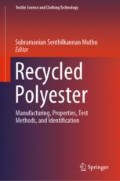Abstract
Recycled polyesters are basically derived from the used and waste polyester bottles, old garments and industrial polyester waste, subsequently these recycled polyesters are prepared using two various methodologies such as Chemical and mechanical recycling methods. There is no much difference between virgin polyesters and recycled polyesters in terms of high strength, durability, versatility, and performance. As the Co2 emission is less in the production of recycled polyesters, it does not pose any threat to the environment. This polyester also reduces the wastage of petroleum fuels which is a major constituent in the production of polyesters, Moreover, it leads to a reduction of overall carbon foot print of the polyester production. The recycled polyesters possess outstanding and enhanced mechanical and thermal properties. This chapter depicts the various fantabulous properties and characteristics of recycled polyesters in detail.
Access this chapter
Tax calculation will be finalised at checkout
Purchases are for personal use only
References
Chae Y, An YJ (2018) Current research trends on plastic pollution and ecological impacts on the soil ecosystem: a review. Environ Pollut 240:387–395
Wang M, He Y, Sen B (2019) Research and management of plastic pollution in coastal environments of China. Environ Pollut 248:898–905
Nikles DE, Farahat MS (2005) New motivation for the depolymerization products derived from poly(ethylene terephthalate) (PET) waste: a review. Macromol Mater Eng 290:13–30
Grigore ME (2017) Methods of recycling, properties and applications of recycled thermoplastic polymers. Recycling 2:24
Liubartseva S, Coppini G, Lecci R (2019) Are mediterranean marine protected areas sheltered from plastic pollution? Mar Pollut Bull 140:579–587
Stafford R, Jones PJS (2019) Viewpoint—Ocean plastic pollution: a convenient but distracting truth? Marine policy 103:187–191
Sarioglu. E, Kaynak HK (2018) PET bottle recycling for sustainable textiles. In: Camlibel NO (ed) Polyester—production, characterization and innovative applications. Intech open science, New York
Vadicherla T, Saravanan D, Muthu SSK (2015) Polyester recycling—Technologies. In: Muthu SSK (ed) Characterisation, and applications, environmental implications of recycling and recycled products, pp 149–165
Filho WL, Ellams D, Han S, Tyler D, Boiten V, Paço A, Moora H, Balogun AL (2019) A review of the socio-economic advantages of textile recycling. J Clean Prod 218:10–20
McKeen LW (2010) Polyesters. In: McKeen LW (ed) Fatigue and tribological properties of plastics and elastomers, 2nd edn, pp 99–147
Fletcher K (2012) Sustainable fashion and textiles: design journeys. Routledge, London
Awaja F, Pavel D (2005) Recycling of PET. Eur Polym J 41:453–1477
Upasani PS, Jain AK, Save N, Agarwal US, Kelkar AK (2011) Chemical recycling of PET flakes into yarn. J Appl Polym Sci 123:520–525
Karayannidis GP, Achilias DS (2007) Chemical recycling of poly (ethylene terephthalate). Macromol Mate Eng 292:128–146
Giannotta G, Po’ R, Cardi N, Tampellini E, Occhiello E, Garbassi F, Nicolai L (1994) Processing effects on poly(ethylene terephthalate) from bottle scraps. Polym Eng Sci 34:1219–1223
Yuksekkaya ME, Celep G, Dogan G, Tercan M, Urhan B (2016) A comparative study of physical properties of yarns and fabrics produced from virgin and recycled fibers. J Eng Fibers Fabr 11
Jo BW, Park SK, Kim CK (2006) Mechanical properties of polyester polymer concrete using recycled polyethylene terephthalate. ACI Struct J 103
Jo BW, Park SK, Park JC (2008) Mechanical properties of polymer concrete made with recycled PET and recycled concrete aggregates. Constr Build Mater 22:2281–2291
Lina X, Yu J, Lia H, Lam JYK, Shih K, Sham IML, Leung CKY (2018) Recycling polyethylene terephthalate wastes as short fibers in strain–hardening cementitious composites (SHCC). J Hazard Mater 357:40–52
Lei Y, Wu Q, Clemons CM, Guo W (2009) Phase structure and properties of poly(ethylene terephthalate)/high-density polyethylene based on recycled materials. J Appl Polym Sci 113:1710–1719
Naguib HM (2018) Environmental-friendly recycled Polyester/Mg(OH)2 nanocomposite: fire-retardancy and thermal stability. Polym Testing 72:308–314
Delva L, Hubo S, Cardon L, Ragaert K (2018) On the role of flame retardants in mechanical recycling of solid plastic Waste. Waste Manage 82:198–206
Lee Y, Joo C (2003) Sound absorption properties of recycled polyester fibrous assembly absorbers. AUTEX Res J 3
Patnaik A, Mvubu M, Muniyasamy S, Botha A, Anandjiwala RD (2015) Thermal and sound insulation materials from waste wool and recycled polyester fibers and their biodegradation studies. Energy Build 92:161–169
Wang X, Chen J, Tang X, Wang J, Zhu L, Zhang W, Wang H, Li Y, Zhang Q (2019) Biodegradation mechanism of polyesters by hydrolase from Rhodopseudomonas palustris: an in silico approach. Chemosphere 231:126–133
Aizenshtein EM (2010) Still no crisis for polyester fibres. Fibre Chem 42
http://www.tedresearch.net/media/files/Polyester_Recycling.pdf
https://www.unenvironment.org/interactive/beat-plastic-pollution/
https://ethicallysustained.wordpress.com/2013/05/08/polyester-and-recycled-polyester/
Author information
Authors and Affiliations
Corresponding author
Editor information
Editors and Affiliations
Rights and permissions
Copyright information
© 2020 Springer Nature Singapore Pte Ltd.
About this chapter
Cite this chapter
Senthil Kumar, P., Janet Joshiba, G. (2020). Properties of Recycled Polyester. In: Muthu, S. (eds) Recycled Polyester. Textile Science and Clothing Technology. Springer, Singapore. https://doi.org/10.1007/978-981-32-9559-9_1
Download citation
DOI: https://doi.org/10.1007/978-981-32-9559-9_1
Published:
Publisher Name: Springer, Singapore
Print ISBN: 978-981-32-9558-2
Online ISBN: 978-981-32-9559-9
eBook Packages: EngineeringEngineering (R0)

